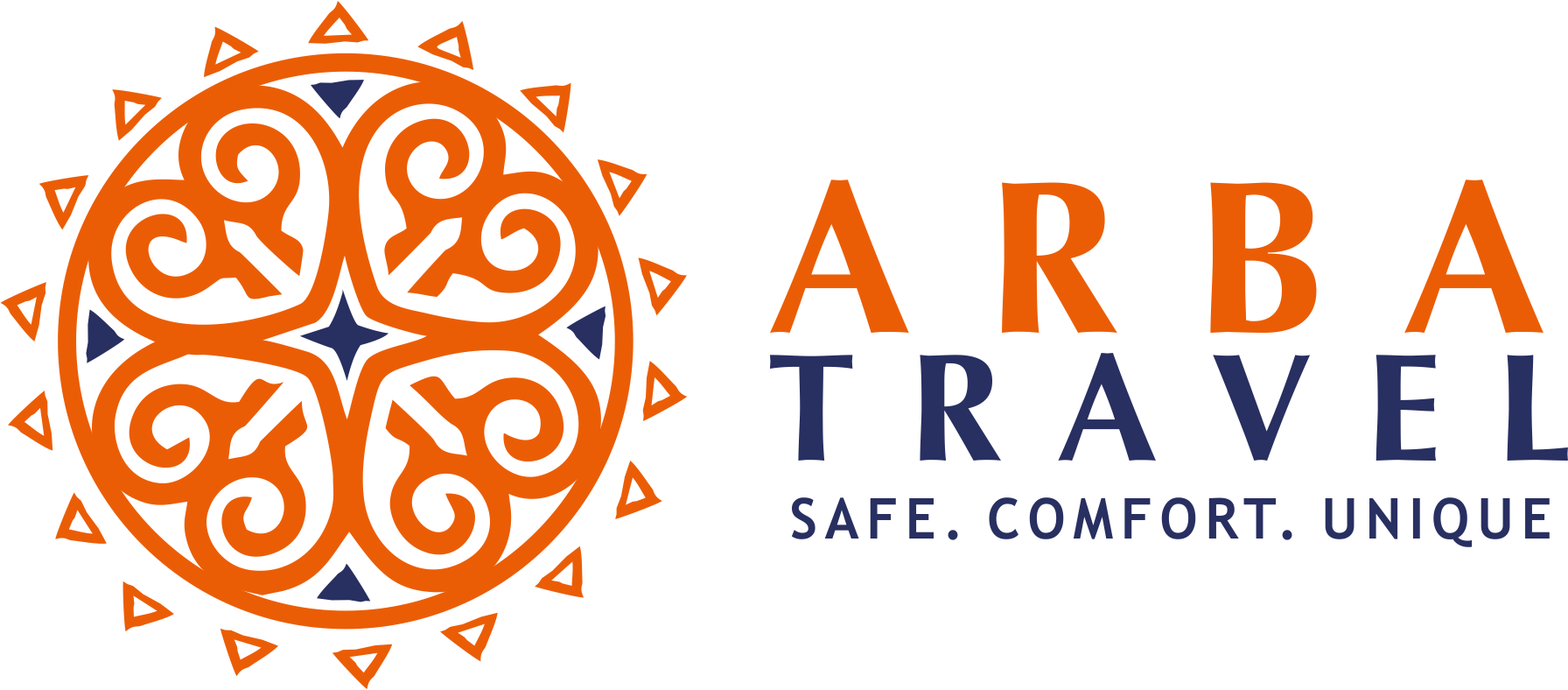Mammals
GO TO ALTYN-EMELMammals in the Altyn-Emel National Park are represented by 7 orders, 70 species, 14 of which are listed in the Red Book of Kazakhstan (marked with an asterisk):
1. Turkmen Kulan* - Equus hemionus onager
2. Przewalski's Horse* - Equus przewalskii
3. Red Deer* - Cervus elaphus
4. Gazelle* - Gazellа subgutturosa
5. Saiga* - Saiga tatarica
6. Argali* - Ovis ammon
7. Asian Barbastelle* - Barbastella leucomelas
8. Tien Shan Brown Bear* - Ursus arctos
9. Stone Marten* - Martes foina
10. Marbled Polecat* - Vormela peregusna
11. Central Asian Otter* - Lutra lutra
12. Pallas's Cat* - Felis manul
13. Turkestan Lynx* - Lynx lynx
14. Ounce, Snow Leopard* - Uncia uncia
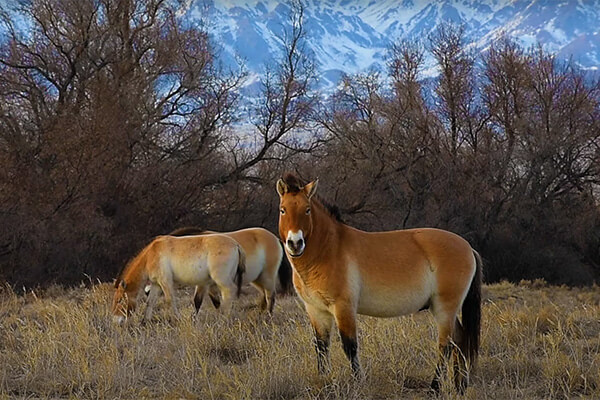
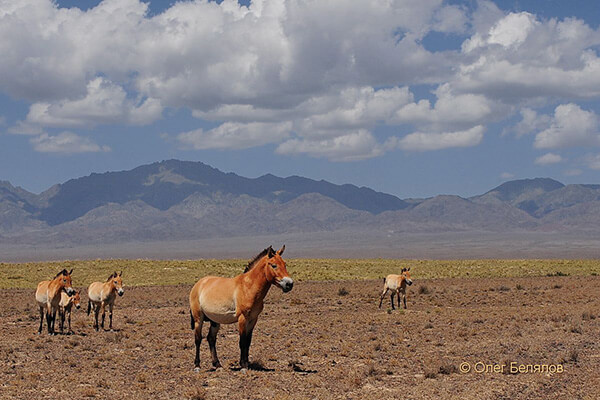
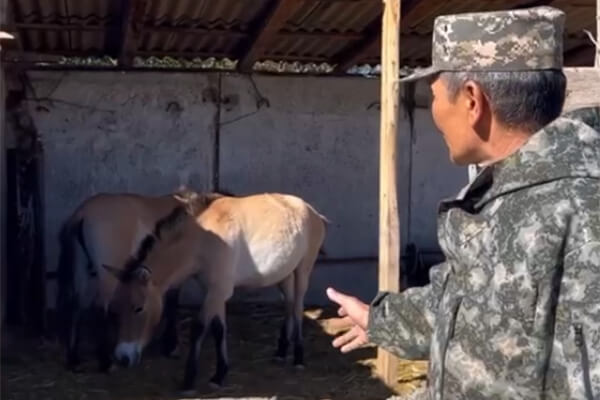
Przewalski's Horse* - Equus przewalskii
Until the 19th century, herds of these wild horses inhabited vast areas of the plains of Kazakhstan, but by the beginning of the 20th century, the Przewalski's horse had completely disappeared in the wild, and only a small number survived in several zoos. This small population allowed for the restoration of the species in various places of its former range.
The extremely limited original gene pool of modern Przewalski's horses creates serious problems: the inevitable inbreeding affects the survivability of the population and the ability to reproduce. Keeping semi-free also has a negative effect on the horses: in nature, wild horses were in constant motion, walking many kilometers during the day.
The Przewalski's horse is the only wild horse in the world today. It was previously thought to be the ancestor of modern domestic horses, but recent research indicates that it is most likely an older species (3700 - 3100 BC), a feral descendant of an already domesticated horse, which for some reason became extinct, and the successful domestication of the horse took place much later, in the Bronze Age.
The Przewalski's horse is included in the Red Book of Kazakhstan and the Red List of the International Union for Conservation of Nature (IUCN) as a rare endangered species.


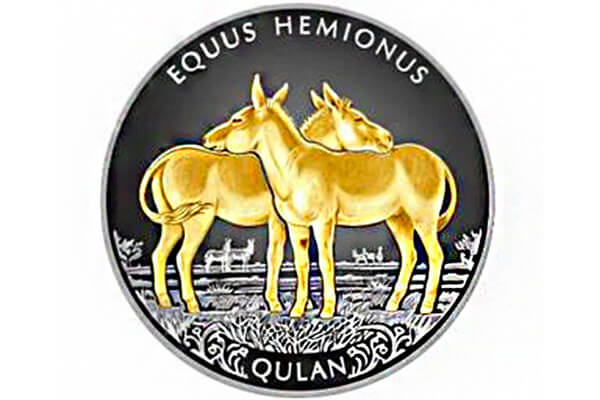
Turkmen Kulan, Asiatic Wild Ass, Onager* - Equus hemionus onager
At one time, kulans inhabited almost the entire desert and semi-desert zones of Kazakhstan, but were completely destroyed by the middle of the 20th century. It was a Kazakh subspecies of the kulan, now completely extinct.
In 1953, eight kulans of the Turkmen subspecies (onager) were brought to the Barsakelmes Island in the Aral Sea, where they naturalized well. In February 1982, due to the deterioration of the ecological situation on the island, twenty-three Turkmen kulans were brought to the northern bank of Kapchagai. The animals settled well in their former habitats (the Ili depression is a fragment of the range of this species in the past), and in the spring the first crop of kulans appeared, whose homeland was Altyn-Emel.
For more than 30 years, the number of kulans of Altyn-Emel has increased a hundred times - their livestock today is more than 3000 heads (3607, as of 2021). This is the largest population in the world.
The kulan is a species from the equidae family. Outwardly, it looks very much like a donkey, but it has many features in common with a horse, so the kulan is often called a semi-donkey.
Kulans prefer to stay in open areas with pastures and water bodies. Kulans are constantly migrating animals, but with good pastures and watering places, they can stay in the same places for several days.
On the territory of the Altyn-Emel park, kulans keep to the area from the Besshatyr Mounds to the Mynbulak and Shygan posts, as well as in the foothills of Matai, Degeres, Sholak, in the vicinity of the Zhantogai post, and in the Kyzylauyz gorge. Separate groups of kulans are found near the Katutau, Aktau, Kalkans Mountains.
Their food is grasses, wormwood, saltwort, less often shrub fodder. For watering, kulans go to the Kapchagai reservoir and other water sources, more often in the afternoon (after 5 pm).
In summer, kulans graze at a distance of 2 to 5 m from each other, and in winter - very close to each other. Long migrations happen when they go to a watering place or move to another pasture.
The kulan is included in the Red Book of Kazakhstan and the Red List of the International Union for Conservation of Nature (IUCN) as a rare and vulnerable species.
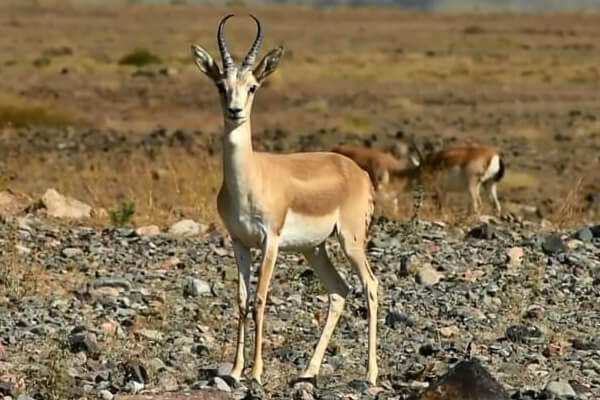
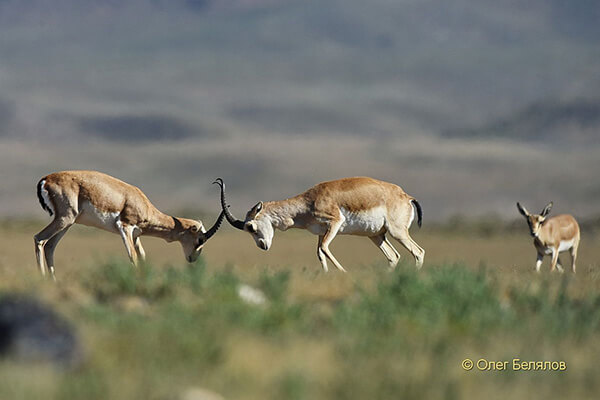
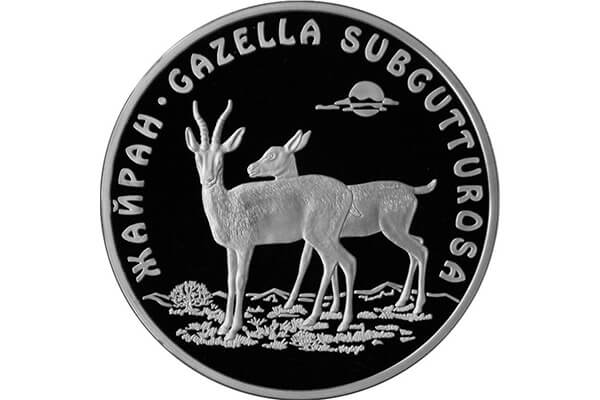
Gazelle, Persian Gazelle, Jeyran* - Gazellа subgutturosa
Gazelles are found everywhere on the plains of the Altyn-Emel National Park. Half a century ago, these graceful animals found themselves on the verge of extinction. Now, thanks to the protected status in the Altyn-Emel National Park, the local population of gazelles has reached 5000 heads (5181 heads were counted during wintering in the park in February 2020).
The number of gazelles in the park varies over the years and seasons, that depends on their migration within their range. Gazelles mainly come from the Almaty region. The exact number of animals that make up the sedentary Altyn-Emel group is unknown, since gazelles are counted only during the wintering period.
In the Altyn-Emel Park, the lay of the lands and the distribution of vegetation make possible for gazelles to use almost the entire territory of the park all year round - the flat part and foothills of Sholak, Degeres, Matai, Big and Small Kalkans, Katutau and Aktau, where they concentrate in early spring. In summer, gazelles are divided into small herds and are found throughout the park, preferring areas with rich vegetation in small saxaul forests. In autumn, the main population of gazelles moves to the foothill zone, where there is more green grass than on the flat part of the park. In winter, saxaul forests and areas with shrub thickets are their main habitat.
The key factor is the state of the snow cover; therefore, the habitats of gazelles are limited to areas with a snow cover of no more than 10 cm.
In early spring, gazelles in some years move outside the park, crossing the Sholak Mountains to the northern slopes and further to the Sary-Esik-Atyrau desert, and in the fall, with the onset of cold weather and snowfall, they return back to the intermountain valley of Kalkans and Matai.
Daily movements of gazelles are also observed throughout the park. From the Kapchagai reservoir and the Ili River, they pass to the foothills of Sholak, Degeres, Matai in the morning, and back in the evening. The same can be seen in the area of the Katutau Mountains. From the Mynbulak oasis to the foothills of Small Kalkan, they move daily in the morning, and descend back to the plain in the evening.
The food of the gazelle is diverse: lichens, grasses, herbs, suffrutices and shrubs (leaves, shoots, fruits). In the Ili valley, they feed on wormwood, saltwort, adder's grass, astragali, conifers and saxauls all year round.
In the spring gazelles water from numerous khaks (puddles on takyrs in Central Asia with melt and rain water); in summer they visit watering places 2-3 times a day. Gazelles often approach the Kapchagai reservoir along dry river beds; they also drink water in the springs of the Mynbulak oasis.
The gazelle is included in the Red Book of Kazakhstan and the Red List of the International Union for Conservation of Nature (IUCN) as a rare and endangered species.
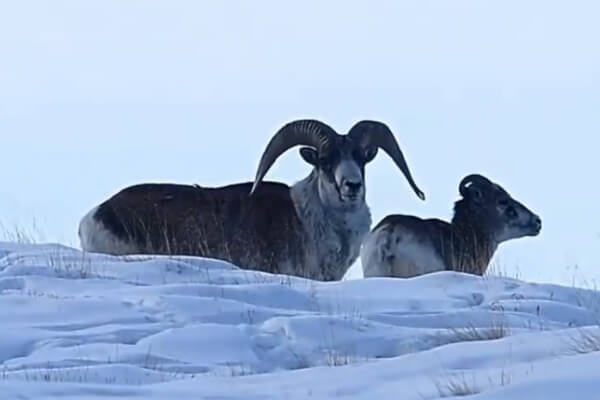


Argali, Arkhar, Mufflon, Tien Shan Wild Sheep* - Ovis ammon
A rare species of ungulates. It lives in the Katutau, Kalkans Mountains, in the low mountains of Dzhungarian Alatau.
The population of the argali in the Altyn-Emel National Park does not exceed several dozen (172 heads as of 2021). For this wild sheep, seasonal migrations outside the protected area are typical. Having left Altyn-Emel, they are deprived of proper protection, and herds return back with noticeable losses.
The argali lives mainly in open spaces with slightly rugged relief: plateaus, gentle slopes of mountains, rugged foothills; they are rare on vast plains. Their pastures are with low-grass steppe or mountain-steppe vegetation.
In the Altyn-Emel park, in summer, the argali lives in the Small and Big Kalkan, Katutau, Aktau, Sholak Mountains; in the Degeres and Matai Mountains, it is found only in some gorges.
When snow cover forms, the argali living in high mountainous areas move to low mountainous areas, where the depth of snow cover does not exceed 20-30 cm. Spring-summer migrations of the argali begin in late May and continue until the end of June. From the Kalkans Mountains, the argali migrate to the Sholak, Degeres, Matai Mountains, crossing the intermontane basin, 15-20 km long.
Autumn mass migration of the argali usually begins in mid-October and ends in early December. Most of the animals return to their winter habitats at the beginning of the estrus.
The argali mainly eats feather grass and creeper in the spring. Feather grass predominates in the diet in summer and winter. In summer, they also eat meadowsweet, saltwort, fescue. In autumn, onions prevail in the diet; in winter, the argali also eats branches of white saxaul and tamarisk.
The argali can go without water for a long time. There is only one water source in the Kalkans Mountains, located in the valley between the Big and Small Kalkans. The argali visits it regularly during the warm season. Animals living far from this source have to descend to the Ili River plain. They come to the river in the morning, less often in the afternoon and in the evening. During the rainy season, animals use the water that has accumulated in various holes in the ground. In winter, the argali eats snow, which remains in shaded areas until mid-April.
The population density of the argali in different parts of the mountain ranges of the park varies. The highest density is currently observed in the Big Kalkan and Katutau Mountains.
The argali is included in the Red Book of Kazakhstan and the Red List of the International Union for Conservation of Nature as a rare and vulnerable species.



Ounce, Snow Leopard* - Uncia uncia
In the 50-80s of the 20th century, the snow leopard constantly lived in all south-west mountain ranges of Dzhungarian Alatau, as well as in the desert mountains of Katutau and Aktau, where it followed herds of the Siberian ibex and argali. Currently, the snow leopard does not constantly inhabit the territory of the national park, but comes in when following migrating herds of the Siberian ibex in winter. The fate of the snow leopard depends on the well-being of the ungulates.
The snow leopard has a protective coloring which makes it hard to notice against the background of stones and grass. The animal is very careful and keeps out of people's sight. Nevertheless, poaching made the species very vulnerable, and its population is tragically small nowadays.
Single sightings of the snow leopard were in the Aktau Mountains and in the Uzynbulak gorge of Dzhungarian Alatau, where traces of the animal are noted at the present time. In the Matai Mountains, the snow leopard was found in 2008, in the Degeres and Sholak ridges - in 2020-2021.
The snow leopard is included in the Red Book of Kazakhstan and the Red List of the International Union for Conservation of Nature (IUCN) as a rare and endangered species.
23rd October is celebrated as the International Snow Leopard Day.
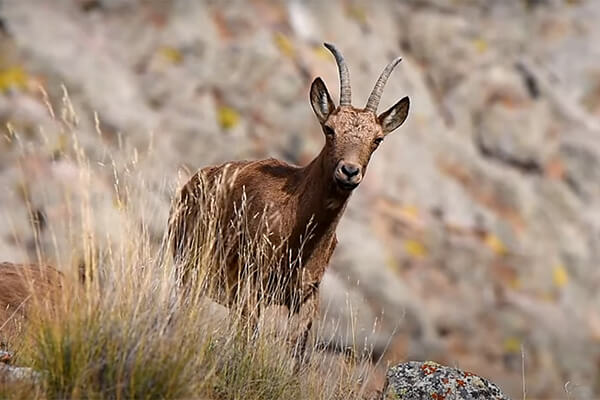


Siberian Ibex - Capra sibirica
A common species of ungulates inhabiting all the southwestern spurs of Dzhungarian Alatau. The main habitats of ibex are areas with outcrops of rocks at altitudes from 600 to 2500 m. With onset of summer, most of their livestock migrates to the northeast to high-altitude pastures. And with onset of autumn, it comes again to the low and middle mountains of Sholak, Degeres, Matai and Altyn-Emel.
Ibex are often seen on cliff tops, they can stand motionless for hours, watching what is happening below. It is a very cautious animal, sometimes only the sound of falling rocks gives away its presence. The ibex have a unique ability to cling and climb almost vertical bare rocks thanks to the structure of its hooves.
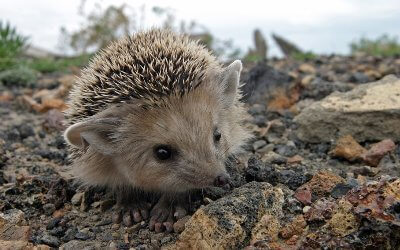
Eared Hedgehog - Erinaceus (Hemiechinus) auritus. A relatively widespread species in the territory of the national park, inhabiting the plain and foothill zones. The most preferred habitats are flat, slightly dissected plains, composed of sands, loams, rubble with tasbiyurgun, teresken, saxaul vegetation, and tugais forests. The abundance has been low in recent years.
Lesser Shrew - Sorex minutus. A common forest species found along the steppe foothills to the subalpine belt throughout the Dzhungarian Alatau massif, as well as in floodplains. The abundance is low.
Tundra Shrew - Sorex tundrensis. It lives within the borders of the national park, mainly in mountainous areas at an altitude of up to 1800 m. Prefers talus, slopes with bushes. The abundance is low.
Lesser White-Toothed Shrew - Crocidura suaveolens. The most common insectivorous species in Kazakhstan in almost all types of habitats.
Eurasian Water Shrew - Neomys fodiens. Inhabits the mountain rivers of the southwestern spurs of Dzhungarian Alatau. The abundance is low.
Piebald Shrew - Diplomesodon pulchellum. It is found along the sandy massifs of the Ili valley. The abundance is low.
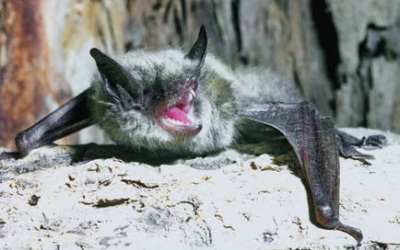
Whiskered Bat - Myotis mystacinus. A common and one of the most numerous species in the Ili basin. The wide ecological plasticity of the whiskered bat determines its habitat in a wide variety of conditions, including deserts, far from water sources.
Particolored Bat - Vespertilio murinus. Widespread in the Palaearctic, inhabits all Kazakhstan lands (deserts, mountains, foothills); not uncommon in urban and rural settlements. Within the limits of the national park, it was found near the Kalkans and Sholak mountains (Kyzylauyz gorge). The abundance is low.
Northern Bat - Eptesicus nilson (gobiensis). Inhabits mountains and intermontane areas (Altai, Dzhungarian Alatau, Zaili Alatau). In the south it is represented by the southern subspecies, the Gobi bat, although there were also several specimens of the northern (nominal) subspecies obtained in wintertime. The abundance is low.
Serotine Bat - Eptesicus serotinus. It is widespread in the south of Kazakhstan. Inhabits the zone of deserts, semi-deserts, steppes and low-mountain landscapes. A typical sinanthrope (whose lifestyle is closely connected with a man and his dwelling), often with high abundance.
Noctule Bat - Nyctalus noctula. It is common in the foothills of the entire southeast of Kazakhstan, including the Altyn-Emel park. It is found not only in the spurs of Dzhungarian Alatau, but also in the Ili river valley, mostly in villages near water. The abundance is high.
Lesser Mouse-Eared Bat - Myotis blythi. Large colonies were observed in a number of places near the borders of the national park.
Greater Horseshoe Bat - Rhinolophus ferrumequinum. A small number is found in the Sholak mountains, in stone and loess caves and niches near water sources.
Grey Long-Eared Bat - Plecotus austriacus. A widespread species in the Palaearctic. Within the limits of the national park, it is found near its northern borders. Keeps to the foothill and mountain regions from 700 m and above. A sedentary species. The abundance is low.
Common Pipistrelle - Pipistrellus pipistrellus. Widely distributed in the Palaearctic. A typical sinanthrope (whose lifestyle is closely connected with a man and his dwelling). It is found in the south-east of Kazakhstan and in the Altyn-Emel National Park, in the Sholak mountains and in the floodplain of the Ili river.
Asian Barbastelle* - Barbastella leucomelas. A very rare species for Kazakhstan. According to the environmental characteristics, it is very likely to stay in the territory of the national park.
Listed in the Red Book of Kazakhstan.
Savi's Pipistrelle - Pipisrtellus savii. A representative of southern complexes, widespread in the low mountains of Tien Shan and Dzhungarian Alatau up to the northern Balkhash region; found in the Ili depression in the Katutau mountains. Keeps to the lands with water sources.

Small Five-Toed Jerboa - Allactaga elater. It is found quite often on the territory of the national park. The largest number of jerboas was recorded in the deserted foothills south of the Sholak Mountains.
Lesser Five-Toed Jerboa - Pygerethmus pumilio. Common within the national park. Keeps to to both clayey and debris areas of the desert - as a rule, in the lowest areas.
Thick-Tailed Three-Toed Jerboa - Stylodipus telum. Single finds of this jerboa refer to a small area of the upper terrace of the Ili river on the eastern border of the national park.
Northern Three-Toed Jerboa, Hairy-Footed Jerboa - Dipus sagitta. Inhabits the sands of Japalakkum on the eastern periphery of the national park.
Severtzov's Jerboa - Allactaga severtzovi. A common species near the Zhantogai and Shygan posts. Relatively numerous in one area in the vicinity of Besshatyr on a flat clay plain with keireuk vegetation.
Tien Shan Red-Backed Vole - Clethrionomys centralis. This species is endemic to the Tien Shan system. It is found in the Altyn-Emel mountains in light coniferous forests.
Silver Mountain Vole - Alticola argentatus. It is common throughout Dzhungarian Alatau from 700 m to the uppermost belt. Repeatedly found on rocks and screes in the Matai and Altyn-Emel mountains.
Narrow-Headed Vole - Microtus gregalis. It is not uncommon in the mountain steppe and juniper forests of the Matai and Altyn-Emel ranges.
Northern Mole Vole - Ellobius talpinus. Burrows-colonies of these rodents in the form of an almost continuous belt 10 to 120 m wide stretch from Checkpoint 1 to the Big Kalkan mountains. Their settlements are located along the bank of the Kapchagai reservoir (some of them are 10 m from the water's edge) and along the right bank of the Ili river. The concentration of burrows is up to 3 per 1 ha. To the north of this belt, the concentration of burrows is much lower.
Kirghiz Vole - Microtus kirgisorum. Occurs in the mountain steppe of the Matai and Altyn-Emel ranges.
Water Vole - Arvicola terrestris. Occasionally occurs on the territory of the national park, inhabiting the floodplain of the Ili river.
Tien Shan Birch Mouse - Sicista tianschanica. Inhabits woodlands of the Altyn-Emel ridge from foothills to the alpine belt with a low abundance.
House Mouse - Mus musculus. It ranks second place in occurrence from the group of murine rodents. It is found both in human housing and in natural places (deserts and mountains).
Wood Mouse - Apodemus sylvaticus. It is a common species of rodents in mountain habitats. It was found along the floodplains of the Sholak, Taigak, Kyzylauyz, Taldy, Sulumtai, Sarybastau, Uzynbulak rivers, as well as in the Mynbulak, Kuyiktumy oases, and Kokterek floodplain forests on the eastern border of the national park.
Gray Marmot - Marmota baibacina. It is only found in the Altyn-Emel ridge in “island” settlements with a low abundance. Along the Uzynbulak gorge, it lives at an altitude of more than 2000 m. It is quite widespread in the upper part of this gorge in the Kensai place. The number of marmot settlements is gradually decreasing to the west. These are the Oryntaysay, Erenshisay, Sapak gorges. Farther west, in the Ayulysay gorge, the marmot is already not found. In general, in the Altyn-Emel mountains, gray marmots live in high-mountainous steppes, meadows, and sometimes in juniper forests. Their settlements occupy small areas and are isolated by rocks and narrow gorges at an altitude of 2000-2700 m.
Squirrel - Sciurus vulgaris. Since it inhabits the fir and spruce forests of the Dzhungarian Alatau mountais, it is quite probable that it enters the spruce woodlands in the extreme north-east of the national park, especially in lean years. These are the upper reaches of the Uzynbulak river, the Karagaily-asha, Toktysai, Kyzylauyz gorges, and others.
Red-Cheeked Ground Squirrel - Spermophilus erythrogenys. Occasionally occurs in the foothill zone of the Altyn-Emel mountains. Its single burrows were found in the lower part of the Uzynbulak and Bokkora gorges.
Long-Tailed Ground Squirrel - Spermophilus undulates. A common species in the Altyn-Emel mountains. Not found in the Matai, Degeres and Sholak mountains. Inhabits the highlands, less often in the middle mountains. It is found in the subalpine and alpine belts up to rocks, as well as in open areas along the Uzynbulak gorge at altitudes from 1600 to 2700 m. Settlements of the ground squirrel in the form of "spots" are found everywhere, starting from the eastern border of the park (the Taldy gorge). The main gorges where this species lives from east to west are Taldy, Kyzylauz, Kopakbai, Uzynbulak, Bayshoky, Shaitansai, Ayulysay, Madina, Myrzabek, Bokkora. To the west, in the Tulkilisay gorge, there is no long-tailed ground squirrel.
Muskrat - Ondatra zibethicus. A naturalized species. It is often found in the reservoirs of the Ili river basin. Inhabits the right bank of the Ili river and the coast of the Kapchagai reservoir.
Great Jerbil - Rhombomys opimus. A common, keytone species, edificator (environment-forming) of rodents of the national park. Burrows-colonies of it are found almost throughout its territory. Single chains of colonies in the far west (Checkpoint 1) gradually expand in places to continuous settlements of great gerbils (the Besshatyr place, the Mynbulak oasis) and further to the south and east. Some areas, for example, takyrs and salt marshes south of Katutau, are almost devoid of burrowing colonies of these rodents.
Forest Dormouse - Dryomys nitedula. Within the national park it lives in the tugai forests of the Ili river valley, as well as in the floodplain forests of the southwestern spurs of the Dzhungarian Alatau mountains.
Eversmann's Hamster - Allocricetulus eversmanni. A new species in the mammalian fauna of the national park as a result of the expansion of the hamster's habitat to the southwest from the Alakol lake to the Ili depression.
Grey Dwarf Hamster - Cricetulus migratorius. Inhabits dry meadows, steppes and semi-deserts.
Tamarisk Jird - Meriones tamariscinus. After the Libyan jird, it is the most common jird. Inhabits tamarisk thickets, both pure and mixed with saxaul on sandy and loamy soils. Inhabits both the floodplain of the Ili river and isolated shrublands to the north.
Midday Jird - Meriones meridianus. A common psammophilic (living in sands) species on the territory of the national park. It ranks second in numbers after the Libyan jird. Relatively more numerous in colonies of great gerbils in the Zhapalakkum sands in the east of the national park.
Libyan Jird - Meriones libycus. The most important common species in the desert zone, including steppe foothills. The most preferred habitats are caragana shrubs along dry beds, stretching from the Sholak, Degeres, Matai and Altyn-Emel mountains.

Corsac Fox - Vulpes corsac. Occasional for the territory of the national park.
Common Fox - Vulpes vulpes. A widespread species. The population density of foxes is higher along the foothills of Sholak, Degeres and Matai, in some areas of the Kapchagai reservoir bank and the floodplain of the Ili river.
Jackal - Canis aureus. In recent decades, it has been rapidly expanding its range to the east of the Syr-Darya river basin. Currently appears in the Altyn-Emel National Park.
Stoat - Mustela erminea. A widespread forest species, numerous in some places.
Wolf - Canis lupus. A common predator on the territory of the national park. The number is to be controlled, as wolves inflict damage on the hoofed mammals of the park - first of all, the Siberian ibex and gazelle.
Turkestan Lynx* - Lynx lynx. A very rare species. The spread of fragments of spruce forests in the national park suggests a permanent habitation of this taiga animal.
Listed in the Red Book of Kazakhstan.
Central Asian Otter* - Lutra lutra. A rare subspecies with a decreasing number, an inhabitant of the Ili river floodplain.
Listed in the Red Book of Kazakhstan.
Stone Marten* - Martes foina. Inhabits mountainous rocky places of all Dzhungarian Alatau massifs along the northern borders of the national park. Not a particularly rare species, but the number in several areas is decreasing.
Listed in the Red Book of Kazakhstan.
Tien Shan Brown Bear* - Ursus arctos. In the mid 70s of the XX century, it was considered a common species, but its number was low already in those years. In 2001-2005 traces and droppings of the bear were repeatedly found in the upper reaches of the Tulkili and Uzynbulak rivers (Altyn-Emel ridge) and in the Toksanbai gorge on the outskirts of a spruce forest. The habitation of the bear in the Uzynbulak gorge is confirmed by the park inspectors at the present time.
Listed in the Red Book of Kazakhstan.
Snow Leopard, Ounce* - Uncia uncia. In the 50-80s of the XX century, the snow leopard constantly lived in all south-west mountain ranges of Dzhungarian Alatau, as well as in the desert mountains of Katutau and Aktau, where it followed herds of Siberian ibex and argali. Currently, the snow leopard does not constantly inhabit the territory of the national park, but comes in when following migrating herds of Siberian ibex in winter.
Ii is included in the Red Book of Kazakhstan and the Red List of the International Union for Conservation of Nature (IUCN) as a rare and endangered species.
Marbled Polecat* - Vormela peregusna. A rare species with a rapidly diminishing range. Very rare encounters of the marbled polecat were noted in the Dzhapallakum sands in the middle reaches of the Ili river and in the rubble desert near the village of Basshi.
Listed in the Red Book of Kazakhstan.
Steppe Polecat - Mustela eversmanni. Inhabits flat plains. The abundance is low.
Steppe Wild Cat - Felis libyca. It is found in the valley of the Ili river and in the foothills of Dzhungarian Alatau. Most of the wild cats live in saxaul thickets and along the floodplain of the Ili river, especially in the east of the national park.
Pallas' Cat* - Felis manul. A rare cat species. Single specimens are found in the desert low mountains of Sholak, Degeres, Matay and Altyn-Emel.
Listed in the Red Book of Kazakhstan.
Weasel - Mustela nivalis. A common, widespread species. On the territory of the national park, it is found in desert habitats, as well as in mountain ranges in rodent settlements.
Badger - Meles meles. A common species of the weasel family. The traces of the badger's habitat and the animals themselves have been repeatedly found along the floodplain of the Ili river, as well as in the Altyn-Emel and Matai mountain ranges. Permanent inhabited burrows were found along the floodplain of the Ili River (Shubyrma and Besmeya oases), in the Matai mountains (Taldy gorge), as well as in the east of the national park near the Kosbastau post.
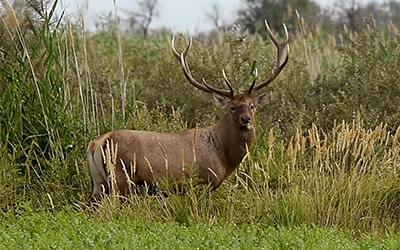
Red Deer, Maral* - Cervus elaphus. A very rare species. One specimen was seen in the spruce woodlands of the Oryntai oasis (the upper reaches of the Uzynbulak river in the Altyn-Emel mountains). Currently, the park staff is working on the semi-free range maintenance of another subspecies of red deer in the tugai forests of the Ili river valley. This is Bukhara deer, hangul* - Cervus elaphus bactrianus.
Both subspecies are included in the Red Book of Kazakhstan and the Red List of the International Union for Conservation of Nature (IUCN) as rare and endangered.
Siberian Roe Deer - Capreolus pygargus. There are two relatively independent populations - the mountain one, which occupies the southwestern spurs of Dzhungarian Alatau, and the tugai one, inhabiting the floodplain of the Ili river. Mountain roe deer make noticeable seasonal vertical migrations. In the spring, they rise to the middle mountains and go to the inner regions of Dzhungarian Alatau. When snow falls, by the end of November, they come to the foothills. Roe deer of the tugai population make only local migrations, occasionally penetrating into saxaul forests, as well as tree and shrub plantations in the northeast of the park.
Siberian Ibex - Capra sibirica. A common species of ungulates inhabiting all the southwestern spurs of Dzhungarian Alatau. The main habitats of ibex are areas with outcrops of rocks at altitudes from 600 to 2500 m. With onset of summer, most of their livestock migrates to the northeast to high-altitude pastures. And with onset of autumn, it comes again to the low and middle mountains of Sholak, Degeres, Matai and Altyn-Emel.
Gazelle, Persian Gazelle, Jeyran* - Gazellа subgutturosa. One of the common species of ungulates. Inhabits the entire territory of the national park, excluding mountainous areas.
It is included in the Red Book of Kazakhstan and the Red List of the International Union for Conservation of Nature (IUCN) as a rare and endangered species.
Saiga* - Saiga tatarica.
The Ili river valley was one of the habitats of this animal in the past. The last saigas (2 specimens) were seen in 2003 near the Mynbulak post. Currently, there is no information about this species in the national park.
It is included in the Red Book of Kazakhstan and the Red List of the International Union for Conservation of Nature as the rarest species in critical condition*.
5th May is celebrated as International Saiga Day.
* In 2022, the number of saigas in Kazakhstan increased dramatically, which raised the question of controlling the population of this species.
Argali, Arkhar, Mufflon, Tien Shan Wild Sheep* - Ovis ammon. A rare species of ungulates. Inhabits the mountains of Katutau, Kalkans. With the onset of heat and the drying up of the grass in mid-June, most of the argali migrate north to the low mountains of Sholak (eastern part), Degeres, Matai. Argali return back to the Kalkans mountains starting from the end of September.
Argali is included in the Red Book of Kazakhstan and the Red List of the International Union for Conservation of Nature as a rare and vulnerable species.
Wild Boar - Sus scrofa. A common species on the territory. The main habitats are along the mountain gorges, from the Kyzylauyz gorge in the west to the Uzynbulak gorge in the east - in small numbers, and in large numbers - in the tugai forests of the Ili river. The wild boar does not live on the plain, especially in the gravelly desert, but it can enter sandy and clayey places. The number of specimens does not change much.
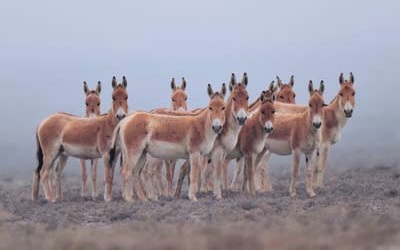
Kulan, Asiatic Wild Ass* - Equus hemionus. The Ili basin is known as a fragment of the past range of this species, where the Kazakh subspecies, Equus hemionus finschii, now extinct, lived. This is even evidenced by the historical name of one of the national park oases, Kulanbasy. At present, another subspecies, the Turkmen kulan, onager* - Equus hemionus onager, has been re-acclimatized here. This event is described in detail in the scientific literature. Kulans settled well in the Altyn-Emel National Park, and now their number is more than 3000 heads.
Kulan is included in the Red Book of Kazakhstan and the Red List of the International Union for Conservation of Nature (IUCN) as a rare and vulnerable species.
Przewalski's Horse* - Equus przewalskii. Until the 19th century, herds of these wild horses inhabited vast areas of the plains of Kazakhstan, but by the beginning of the 20th century, the Przewalski's horse had completely disappeared in the wild, and only a small number survived in several zoos. In 2003, 4 stallions and 4 mares from the Munich Zoo were brought to Altyn-Emel. 3 years later, the first foal crop appeared, and it gives hope that over time, a local population of this wild horse may reappear, and the mammalian fauna will be replenished with another species that once lived on the territory of Kazakhstan.
The Przewalski's horse is included in the Red Book of Kazakhstan and the Red List of the International Union for Conservation of Nature (IUCN) as a rare endangered species.
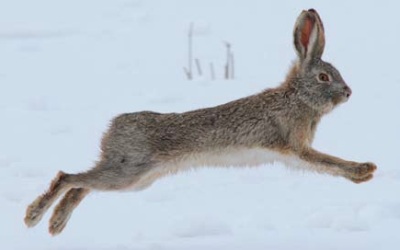
Mountain Hare - Lepus timidus. The northeastern border of the tolai hare range and the southeastern border of the mountain hare range run through the territory of the national park. Their ranges do not border on each other. Between them there is a belt up to 10 km wide, where both species are not found. This is primarily due to the Schrenk's spruce abundant growth, lack of shrubs in the foothill zone, and also, in general, to the naturally low abundance of these species of hares. The mountain hare is found in the Altyn-Emel mountains (the Tulkilisay gorge). In general, along the Altyn-Emel ridge between these species there is a belt about 5 km wide, inside which they are not found. Tolai lives to the south of this belt, and the mountain hare lives to the north.
Tolai Hare - Lepus tolai. It inhabits almost the entire territory of the national park, with the exception of mountainous areas, apparently due to competition with the mountain hare there. Relatively more often, tolai occurs along the Ili river valley in tugai habitats, and also in shrubs (salt tree, saxaul) along the bank of the Kapchagai reservoir. It is more rare in gravelly desert, although separate gatherings of hares are found in saxaul forests, as well as along dry beds.



